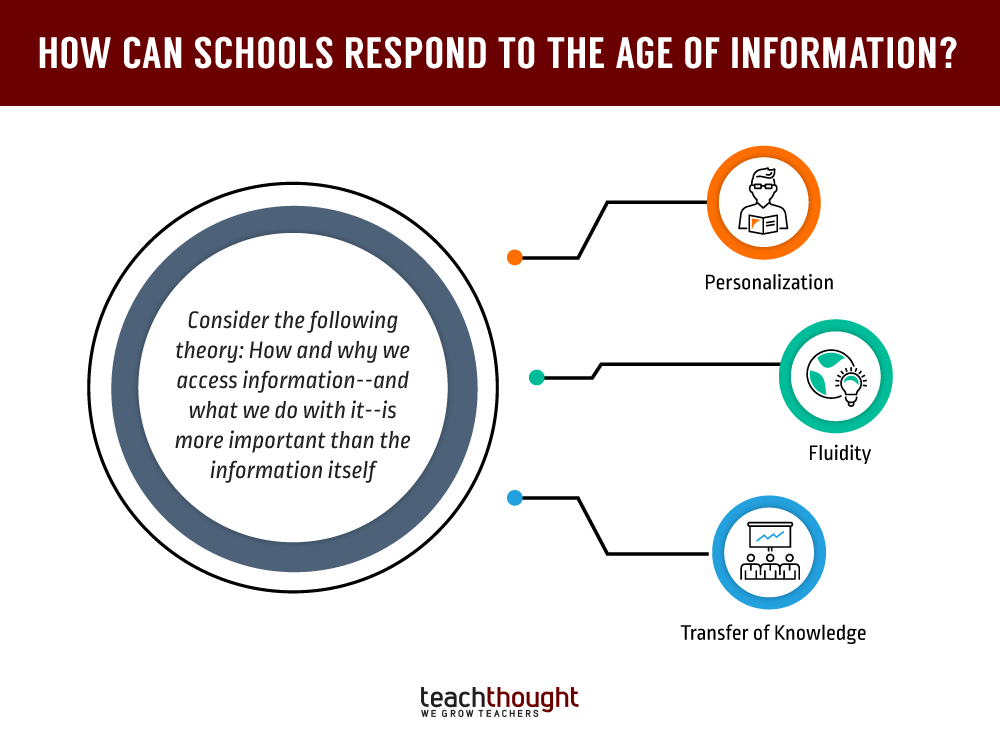
How Can Schools Respond To The Age Of Information?
by Terry Heick
We really all should have seen this coming.
The information used to be here, and there, and over there. Now it’s moving, from a singular there, to a plural everywhere–very much a new age of information and information access.
The response to this access has been slow–and even when swift, it has rarely been compelling or long-lasting.
Information Sources
Historically, when you needed to understand something, you went somewhere—you physically had to move from one place to another. From your home to an expert; your neighborhood to some kind of school. From where you were standing, to somewhere you can experiment.
Libraries for centuries have acted as points of media aggregation that were intellectual and cultural and functioned as lodestones of information. While you still had to seek out the information—you had to go to it—it at least was all in one place. This reduced the activity necessary to retrieve information. Daily newspapers were the closest the mainstream came to passive media collection–each day pages of news and data would show up on your step.
The internet has changed things again, offering virtual libraries and fingertip-access to collective human information lodes. And it can be accessed not simply from computers, but phones and gaming devices. If you consider the growth of the internet not as a cause (of the persistence of information), but an effect (of the basic human need for information in various forms), then the internet itself is simply an intermediary for how people connect—to information, and to one another.
See also The Definition Of Good Work
But there is yet another change enabled by modern, digital information forms and systems: Today, information is becoming infinitely plural. It is packaged and re-packaged, fragmented and aggregated, split into strands, and synthesized again across platforms, devices, and apps in ways that are simply impossible to grasp. You have the New York Times newspaper and live video streaming supplemented by an instagram and notifications that send out breaking news.
And it’s all the same news, but it’s not.
Marshall McLuhan’s insistence that the media is the message continues to not simply resonate, but hum in thrumming spectacle. How we access information is becoming more important than the information itself. The incredible diversity of information forms, and prevalence of devices built to access those increasingly diverse forms, is changing societal interactions with facts and ideas.
This kind of nuanced access is currently being supported through apps. Apple sold more than 40 million iPhones in 2019 and more than two billion since its launch in 2007. It is impossible to qualify the consumer demand that led to that kind of proliferation, as it is equally unlikely one could ever accurately describe the social change engendered by that kind of volume. That number represents billions and billions of consumer decision-making processes–and only the ones that were successful (people with disposable income). Imagine the actual cultural and human demand.
Everything Old is New Again
Remember Google Glass? It was what the name suggested it might be—Matrix-style glasses that allow Google to stream information directly to your eyes via a heads-up display on the glasses. From a general technological standpoint, it wasn’t really isn’t a huge leap from existing augmented reality apps that offer a digital information overlay of a non-digital, physical environment.
See also 3 Ways You Can Respond When Students Turn In Incomplete Work
Before Glass, augmented reality apps like Layar used camera viewfinders to identify locations for users. You’d hold up the camera and pan around, and little digital icons would pop up telling you where coffee was, the phone number of the closest bookstore, or even the average customer rating of that restaurant across the street. In the late 20th century, you would have to ask someone where something was, or where to get a cup of joe in an unfamiliar city. Phone numbers were in a phone book. Restaurant ratings were in the Saturday Post next to Norman Rockwell paintings.
Information access was not only active (as opposed to passive), but it was fragmented–in bits–everywhere. If you trace the evolution of that kind of information, streaming the information right to your eyes (in lieu of being able to beam it straight to your subconsciousness) makes perfect sense. While interesting, iPhones and Google Glass were simply the continuations of that process, and it’s really the process that’s actually interesting. They’re simply landmarks.
Information has moved from singular places (here and there) to infinitely plural realities. Data is now entirely decentralized and fragmented, then re-aggregated and socially forged through apps. Then, through apps, they are re-packaged for personalized delivery to users. And with it not dropped on your doorstep, stored at the local library, or out of the mouth of inaccessible experts, that data’s retrieval is now more passive than ever before. Push technology in your smartphone will send you an alert of a nearby task that needs completing, ‘consumer opportunity,’ or even a field trip idea.
That move from pull (seeking information) to push (that’s automatic and passive) is significant.
Conclusion
In and of itself, this kind of movement will not make an individual any smarter, nor society any more productive. But given the right kinds of needs for information, and the right kind of authentic opportunities for the application of information that’s persistently accessible and consumable, suddenly there is an opportunity for actually improving the planet through highly-consumable data forms–taking real-time facts and statistics and improving basic human interdependence.
Mobile devices and various social media have changed the world, but not as much as we’d think. (And Google Glass changed even less.) They don’t allow the governments to (directly) control our minds or destroy real-life human connections. And even the most avant-garde of technology will gradually be replaced by other emerging methods of providing users access to information and general digital content.
But the macro trends at work here are indeed interesting. The information is constantly duplicating, diversifying, and moving all around us. It’s not simply about more outlets or even more information, but rather an almost overwhelming environment of enormous access. How should education adapt as a result? By un-tethering from classrooms and pursuing fully mobile learning? By changing the role of the teacher as content holder to resource expert and coach? Or by dispensing with the stunningly ambitious and short-sighted goal of content-based learning standards, and instead focus on constantly changing data sources, consumption patterns, and tendency towards critical literacy and human service?
How can schools respond to the age of information? Consider the following theory:
How and why we access information–and what we do with it–is more important than the information itself. In parallel, might it be that how and why students learn–and what they do with what they learn–is more important than the content itself?
